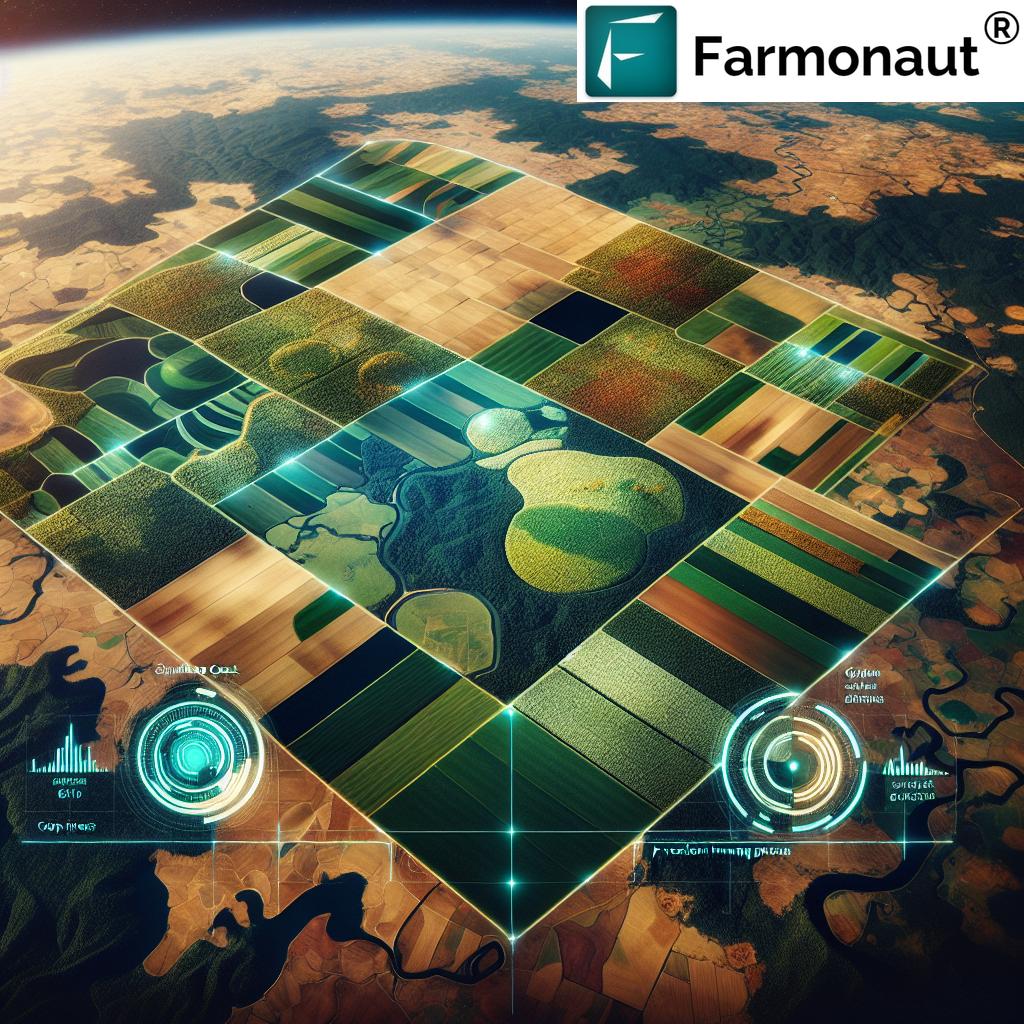Revolutionizing Australia’s Ginger Industry: Innovative Approaches to Sustainable Production and Disease Control
“The ‘Ginger Ninja’ project aims to automate Fusarium detection, potentially saving millions in crop losses annually.”

In recent years, we’ve witnessed a remarkable transformation in Australia’s ginger industry. As we delve into the world of sustainable agriculture practices and innovative approaches to ginger production, we’re excited to share insights from AgriFutures Australia’s comprehensive blueprint. This analysis not only highlights the challenges faced by ginger growers but also showcases cutting-edge solutions that are reshaping the industry landscape.
The Current State of Australia’s Ginger Industry
Australia’s ginger industry has long been a significant contributor to the country’s agricultural sector. However, in recent years, growers have faced numerous challenges that have threatened the industry’s sustainability and profitability. These challenges include:
- Soil health degradation
- Persistent pest infestations
- Devastating crop diseases, particularly Fusarium
- Climate change impacts
- Market volatility
To address these issues and secure the future of ginger production in Australia, industry leaders and researchers have been working tirelessly to develop innovative solutions and sustainable practices.
Innovative Approaches to Sustainable Ginger Production
The ginger industry is embracing a range of cutting-edge technologies and practices to enhance productivity and sustainability. Let’s explore some of the most promising innovations:
1. The “Ginger Ninja” Project: Automated Fusarium Detection
One of the most exciting developments in the fight against crop diseases is the “Ginger Ninja” project. This innovative system uses advanced imaging technology and artificial intelligence to detect Fusarium infection in ginger crops at an early stage.
How it works:
- High-resolution cameras mounted on autonomous robots scan ginger fields
- AI algorithms analyze plant images to identify subtle signs of Fusarium infection
- Early detection allows for targeted treatment, reducing the spread of the disease
The potential impact of this technology is immense, as it could save the industry millions of dollars in crop losses annually. By identifying infected plants before visible symptoms appear, growers can take swift action to prevent the spread of Fusarium and protect their yields.
2. AI-Powered Weed Control Systems
Weed management is a critical aspect of ginger cultivation, and new AI-powered systems are revolutionizing this process. These advanced systems offer several benefits:
- Precise identification of weed species
- Targeted application of herbicides, reducing chemical usage
- Minimized impact on ginger plants and beneficial organisms
- Increased efficiency and reduced labor costs
By leveraging machine learning algorithms, these systems can continuously improve their accuracy, adapting to different growing conditions and weed varieties.
3. Precision Farming Technologies
Precision farming is transforming ginger cultivation techniques, allowing growers to optimize resource use and maximize yields. Key technologies in this area include:
- GPS-guided planting and harvesting
- Drone-based crop monitoring
- Soil sensors for real-time moisture and nutrient data
- Variable-rate irrigation and fertilizer application
These technologies enable growers to make data-driven decisions, reducing waste and improving overall farm efficiency. For instance, Farmonaut’s satellite-based crop health monitoring system provides valuable insights into vegetation health (NDVI) and soil moisture levels, helping farmers optimize their irrigation and fertilizer usage.
4. Sustainable Soil Health Management
Maintaining soil health is crucial for long-term ginger production. Innovative approaches to soil management include:
- Cover cropping and crop rotation strategies
- Biochar application to improve soil structure and fertility
- Microbial inoculants to enhance nutrient uptake
- Organic matter management techniques
These practices not only improve soil health but also contribute to carbon sequestration, aligning with broader sustainability goals.
Research Priorities for a Resilient Ginger Industry
To address the challenges facing the ginger industry, research efforts are focused on several key areas:
1. Diversification of Ginger Cultivars
“Australia’s ginger industry is focusing on diversifying cultivars to reduce vulnerability, with research targeting at least 3 new varieties.”
The industry’s reliance on a limited number of ginger cultivars poses a significant risk. Research priorities include:
- Developing disease-resistant varieties
- Breeding for improved yield and quality traits
- Exploring wild ginger species for valuable genetic resources
- Evaluating cultivars for climate resilience
By expanding the genetic diversity of cultivated ginger, the industry can better withstand pest pressures, diseases, and environmental stresses.
2. Integrated Pest and Disease Management
Effective pest and disease control is essential for sustainable ginger production. Research in this area focuses on:
- Biological control agents for major pests
- Novel fungicides and application methods for Fusarium control
- Crop rotation strategies to break disease cycles
- Plant-based biofumigants for soil-borne pathogens
These integrated approaches aim to reduce chemical inputs while maintaining crop health and productivity.
3. Improving Soil Fertility and Health
Enhancing soil health is a key priority for long-term industry sustainability. Research efforts include:
- Developing tailored soil amendments for ginger production
- Investigating the role of soil microbiomes in plant health
- Optimizing nutrient cycling in ginger cropping systems
- Assessing the impact of different tillage practices on soil structure
By improving soil health, growers can enhance crop resilience and reduce the need for external inputs.
Leveraging Technology for Ginger Industry Growth
Technology plays a crucial role in the future of Australia’s ginger industry. Here are some key areas where technological advancements are making a significant impact:
1. Satellite-Based Crop Monitoring
Satellite technology is revolutionizing crop management in the ginger industry. Farmonaut’s platform utilizes multispectral satellite imagery to provide valuable insights into crop health and soil conditions. This technology offers several benefits:
- Real-time monitoring of crop health using vegetation indices like NDVI
- Early detection of stress factors, including pest infestations and nutrient deficiencies
- Optimization of irrigation schedules based on soil moisture data
- Improved decision-making for fertilizer application and pest management
By leveraging satellite data, ginger growers can make informed decisions that lead to increased yields and reduced input costs.
2. AI-Driven Advisory Systems
Artificial intelligence is transforming farm management practices in the ginger industry. Advanced AI systems, such as Farmonaut’s Jeevn AI, provide personalized recommendations based on real-time data. These systems offer:
- Customized crop management strategies
- Precise weather forecasts for improved planning
- Pest and disease risk assessments
- Yield predictions and harvest optimization
By harnessing the power of AI, ginger growers can make data-driven decisions that enhance productivity and sustainability.
3. Blockchain for Supply Chain Transparency
Blockchain technology is enhancing traceability and transparency in the ginger supply chain. This innovation offers several advantages:
- Improved food safety through end-to-end product tracking
- Enhanced consumer trust through transparent production practices
- Streamlined certification processes for organic and sustainable production
- Reduced fraud and counterfeiting in the ginger market
By implementing blockchain solutions, the Australian ginger industry can strengthen its position in both domestic and export markets.
Sustainable Practices for Long-Term Industry Growth
Sustainability is at the heart of the ginger industry’s future. Here are some key practices being adopted to ensure long-term growth and environmental stewardship:
1. Water Conservation Techniques
Efficient water use is crucial for sustainable ginger production. Innovative approaches include:
- Drip irrigation systems for precise water delivery
- Rainwater harvesting and storage infrastructure
- Mulching to reduce evaporation and improve soil moisture retention
- Use of drought-tolerant ginger varieties
These practices not only conserve water but also help growers adapt to changing climate conditions.
2. Organic and Regenerative Farming Methods
Many ginger growers are transitioning to organic and regenerative farming practices, which offer numerous benefits:
- Improved soil health and biodiversity
- Reduced reliance on synthetic inputs
- Enhanced ecosystem services on farms
- Premium pricing for organic ginger products
These methods align with consumer demand for sustainably produced foods and contribute to the long-term health of agricultural landscapes.
3. Energy-Efficient Production Systems
Reducing energy consumption in ginger production is a key focus for sustainability. Strategies include:
- Solar-powered irrigation and processing facilities
- Energy-efficient storage and drying technologies
- Optimized transportation and logistics to reduce fuel consumption
- Use of bioenergy from crop residues
By adopting these energy-efficient practices, the ginger industry can reduce its carbon footprint and operational costs.
Collaborative Efforts and Industry Partnerships
The success of Australia’s ginger industry relies heavily on collaboration and partnerships across various sectors. Key initiatives include:
- Joint research projects between universities and industry bodies
- Grower-led field trials of new technologies and practices
- Knowledge-sharing platforms for disseminating research findings
- Mentorship programs connecting experienced growers with new entrants
These collaborative efforts ensure that innovations are quickly adopted and adapted to meet the specific needs of Australia’s ginger growers.
Key Innovations in Australia’s Ginger Industry
| Innovation | Description | Benefit | Implementation Status | Potential Impact |
|---|---|---|---|---|
| “Ginger Ninja” Project | Automated Fusarium detection using AI and imaging technology | Early disease detection and prevention | Testing phase | Up to 30% reduction in crop losses |
| AI-Powered Weed Control | Machine learning algorithms for precise weed identification and targeted herbicide application | Reduced chemical use and improved efficiency | Active use in select farms | 20% decrease in herbicide costs |
| Satellite-Based Crop Monitoring | Real-time crop health assessment using multispectral satellite imagery | Optimized resource management and yield improvement | Widely adopted | 15-20% increase in overall productivity |
| Blockchain Traceability | End-to-end supply chain tracking using blockchain technology | Enhanced transparency and consumer trust | Pilot programs underway | Potential 10% premium on traceable products |
Future Outlook and Opportunities
The future of Australia’s ginger industry looks promising, with several exciting opportunities on the horizon:
- Expanding export markets for high-quality Australian ginger
- Development of value-added ginger products for niche markets
- Integration of ginger production with agritourism initiatives
- Exploration of ginger’s potential in nutraceutical and pharmaceutical applications
By embracing innovation and sustainable practices, the Australian ginger industry is well-positioned to thrive in the years to come.
Conclusion
The Australian ginger industry is at the forefront of agricultural innovation, embracing cutting-edge technologies and sustainable practices to overcome challenges and secure a prosperous future. From the groundbreaking “Ginger Ninja” project to the adoption of precision farming techniques, growers are leveraging a wide array of tools to enhance productivity, combat diseases, and improve resource efficiency.
As we look to the future, the industry’s focus on research, collaboration, and sustainability will be key to its continued success. By fostering innovation, supporting growers, and adapting to changing market demands, Australia’s ginger sector is poised to remain a global leader in sustainable and high-quality ginger production.
For those interested in staying at the forefront of agricultural technology, Farmonaut’s comprehensive suite of tools offers valuable solutions for crop monitoring, farm management, and sustainable agriculture practices. By leveraging satellite imagery, AI-driven insights, and blockchain technology, Farmonaut is helping to shape the future of farming, not just for ginger growers, but for agriculturalists worldwide.
Explore Farmonaut’s innovative solutions:
Frequently Asked Questions (FAQ)
- What is the “Ginger Ninja” project?
The “Ginger Ninja” project is an innovative system that uses advanced imaging technology and AI to detect Fusarium infection in ginger crops at an early stage, potentially saving millions in crop losses annually. - How does satellite-based crop monitoring benefit ginger growers?
Satellite-based monitoring provides real-time insights into crop health, soil moisture levels, and other critical metrics, helping farmers make informed decisions about irrigation, fertilizer usage, and pest management. - What are some sustainable practices being adopted in the ginger industry?
Sustainable practices include water conservation techniques, organic and regenerative farming methods, energy-efficient production systems, and the use of precision farming technologies. - How is blockchain technology being used in the ginger industry?
Blockchain is enhancing supply chain transparency, improving food safety through end-to-end product tracking, and building consumer trust by providing transparent information about production practices. - What are the main research priorities for the Australian ginger industry?
Key research priorities include diversifying ginger cultivars, developing integrated pest and disease management strategies, and improving soil fertility and health.
















